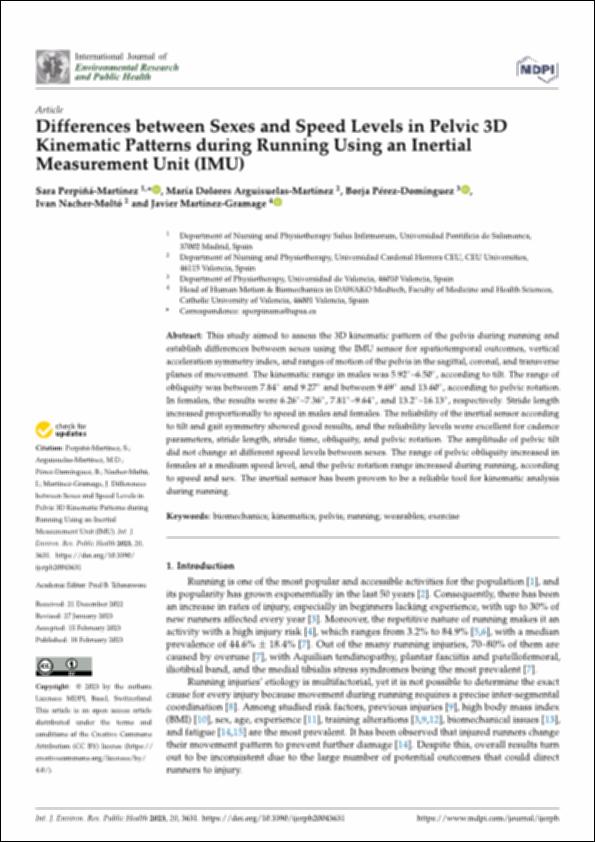Please use this identifier to cite or link to this item:
http://hdl.handle.net/10637/16101Differences between sexes and speed levels in pelvic 3D kinematic patterns during running using an Inertial Measurement Unit (IMU)
| Title: | Differences between sexes and speed levels in pelvic 3D kinematic patterns during running using an Inertial Measurement Unit (IMU) |
| Authors : | Perpiñá Martínez, Sara Arguisuelas Martínez, María Dolores Pérez Domínguez, Borja Nacher Moltó, Iván Martínez Gramage, Javier |
| Keywords: | Biofísica; Human biophysics; Pelvis; Athletics; Atletismo |
| Publisher: | MDPI |
| Citation: | Perpiñá-Martínez, S., Arguisuelas-Martínez, M.D., Pérez-Domínguez, B., Nacher-Moltó, I. & Martínez-Gramage, J. (2023). Differences between sexes and speed levels in pelvic 3D kinematic patterns during running using an Inertial Measurement Unit (IMU). International Journal of Environmental Research and Public Health, vol. 20, i. 4 (18 feb.), art. 3631. DOI: https://doi.org/10.3390/ijerph20043631 |
| Abstract: | This study aimed to assess the 3D kinematic pattern of the pelvis during running and establish differences between sexes using the IMU sensor for spatiotemporal outcomes, vertical acceleration symmetry index, and ranges of motion of the pelvis in the sagittal, coronal, and transverse planes of movement. The kinematic range in males was 5.92°–6.50°, according to tilt. The range of obliquity was between 7.84° and 9.27° and between 9.69° and 13.60°, according to pelvic rotation. In females, the results were 6.26°–7.36°, 7.81°–9.64°, and 13.2°–16.13°, respectively. Stride length increased proportionally to speed in males and females. The reliability of the inertial sensor according to tilt and gait symmetry showed good results, and the reliability levels were excellent for cadence parameters, stride length, stride time, obliquity, and pelvic rotation. The amplitude of pelvic tilt did not change at different speed levels between sexes. The range of pelvic obliquity increased in females at a medium speed level, and the pelvic rotation range increased during running, according to speed and sex. The inertial sensor has been proven to be a reliable tool for kinematic analysis during running. |
| URI: | http://hdl.handle.net/10637/16101 |
| Rights : | http://creativecommons.org/licenses/by/4.0/deed.es Open Access |
| ISSN: | 1660-4601 (Electrónico) |
| Issue Date: | 18-Feb-2023 |
| Center : | Universidad Cardenal Herrera-CEU |
| Appears in Collections: | Dpto. Enfermería y Fisioterapia |
Items in DSpace are protected by copyright, with all rights reserved, unless otherwise indicated.


